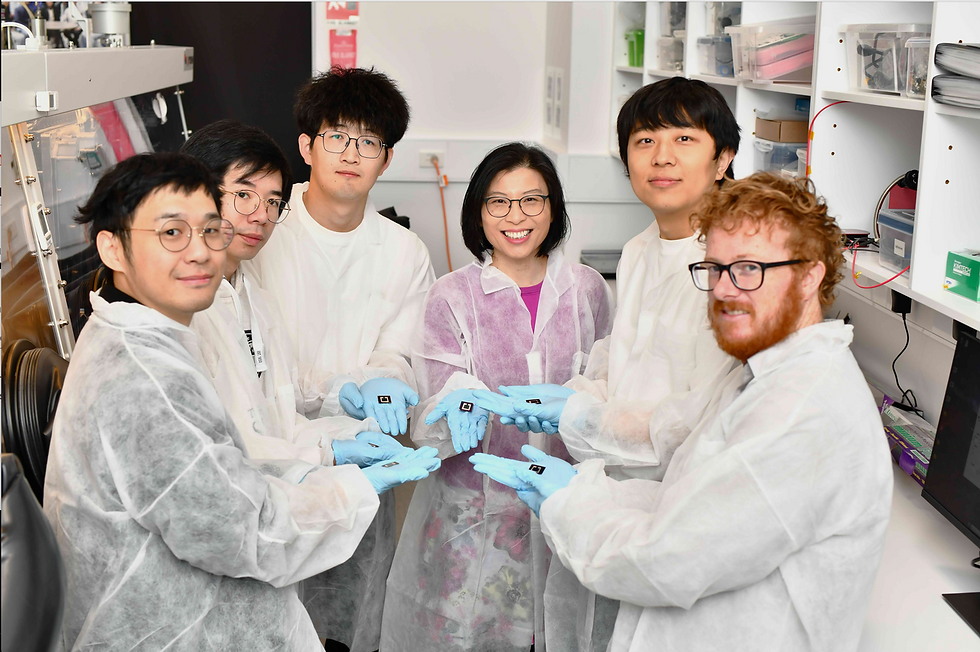Global record for triple-junction tandem solar cell reported by University of Sydney/ACAP-led team
- alisonpotter2
- 1 day ago
- 3 min read
A collaborative team of multi-disciplinary researchers, led by the University of Sydney, has demonstrated record-setting size, performance and durability for perovskite–perovskite–silicon triple-junction solar cells.
The work, published in Nature Nanotechnology (October 2025), achieved independently certified efficiencies of 27.06% (1 cm²) and 23.3% (16 cm²) – the latter representing the most efficient large area perovskite–perovskite–silicon triple-junction solar cell reported to date.
The team also delivered the first triple-junction device of its kind to pass the IEC 61215 Thermal Cycling test, establishing new standards for durability in perovskite-based solar technology.

The work was supervised by Professor Anita Ho-Baillie (University of Sydney, ACAP) and co-led by Dr Jianghui Zheng and Dr Guoliang Wang from the University of Sydney. Dr Zheng, a former ACAP Fellow at UNSW Sydney and Research Fellow at the University of Sydney, is now an Associate Professor at Xiamen University in China.
The study also brought together researchers from the University of Sydney, UNSW, and the Australian National University, working with international partners at Forschungszentrum Jülich, Shenzhen Hiking PV Technology, Wuhan University of Technology (China), and the University of Ljubljana (Slovenia) – a powerful example of the global and interdisciplinary strength of the ACAP network.
Triple-junction solar cells (stacking three sub cells with different bandgaps) are promising because they can harness a broader portion of the solar spectrum more efficiently. In particular, perovskite–perovskite–silicon architectures are attractive because perovskites offer tuneable bandgaps, high absorption, and potentially low-cost fabrication; while silicon is mature, stable and widely used.
However, real devices of this kind have not reached theoretical limits because of voltage losses, stability issues (particularly under heat, moisture, and light exposure) and challenges integrating the perovskite–perovskite and perovskite–silicon junctions.

The success in improving the top perovskite cell stability came from the replacement of the less stable methylammonium, with rubidium creating a layer that is less prone to defects and degradation. A new surface treatment for the top perovskite cell was also developed using piperazine-1,4-diium chloride (PDCl) improving the cell’s light stability.
To precisely engineer the interface between the perovskite cells, gold in the form of nanoparticles was used in favour of a continuous film. The coverage of the nanoparticles was engineered to maximise the flow of electric charge and light absorption by the solar cell.
Achieving high efficiency and durability, with larger cell areas represents a major milestone for next generation of ultra-efficient photovoltaic. Professor Ho-Baillie emphasised that the findings illustrate both the promise and the remaining challenges of perovskite on silicon tandems.
“The results strengthen confidence in the potential of triple-junction perovskite devices. We’re moving closer to real-world application, which is very exciting. Long-term stability and large-scale manufacturability remain as challenges to be tackled,” Professor Ho-Baillie said.
This world record achievement reinforces Australia’s global leadership and ACAP’s pivotal role in advanced solar research.
2025 awards recognise Ho Baillie and Wang’s contribution
Both Prof. Ho Baillie and Dr. Wang were recognised with prestigious Australian awards this year for their pioneering solar technology research. Ho-Baillie received the prestigious Eureka Prize for Sustainability Research for her immense contribution to developing perovskite solar technology, and Dr Guoliang Wang received the University of Sydney Faculty of Science Outstanding PhD Thesis award for his research into improving the efficiency and stability of perovskite–silicon tandem solar cells.
References:
Zheng, J., Wang, G., Duan, L. et al. Tailoring nanoscale interfaces for perovskite–perovskite–silicon triple-junction solar cells. Nat. Nanotechnol. (2025). https://doi.org/10.1038/s41565-025-02015-x




Comments